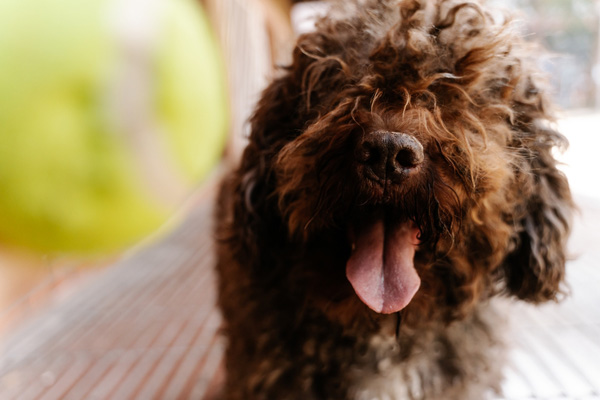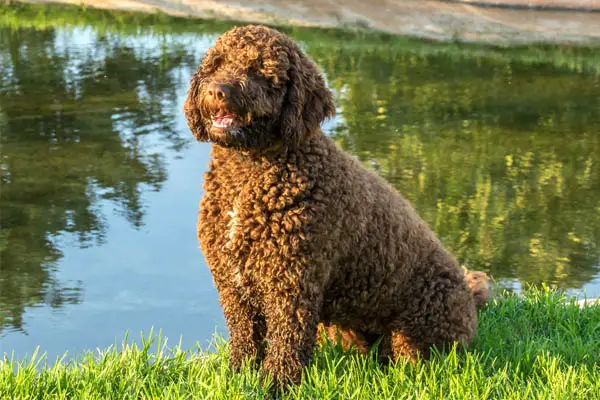Spanish Water Dogs, also called SWD for short, are medium-sized herding dogs from Spain. The Spanish Water Dog is well-known for its curly, cord-like coats that come in shades of white, black, and chestnut. The Spanish Water Dog’s facial hair usually covers their brown eyes.
If you describe these dogs in one word, you would say “rustic.” They are hardy dogs and are best paired with active people who can cope with their exercise needs. They can easily adapt in any type of living condition, cut it’s best if you have space for them to run around.

Spanish Water Dog Statistics
| Dog Breed Group | Herding |
| Breed Size | Medium |
| Height | 17.5-19.75 inches (male); 15.75-18 inches (female) |
| Weight | 40-49 pounds (male); 31-40 pounds (female) |
| Lifespan | 12-14 years |
Spanish Water Dog Ratings
| Energy level | |
| Exercise needs | |
| Requires attention | |
| Playfulness | |
| Trainability | |
| Shedding | |
| Grooming | |
| Friendly with family | |
| Friendly with kids | |
| Friendly with strangers | |
| Friendly with other dogs | |
| Prey Drive |
Spanish Water Dog History
There’s not much known about the Spanish Water Dogs other than the fact that they’re an ancient breed. Their exact origin is unknown, and until now, it has only been theories. However, regardless of where they came from, documentation was found of the existence of a wooly-coated Water Dog in 1110 AD.
These dogs were found in the Iberian Peninsula, and they had a very close resemblance to the Spanish Water Dogs. They are believed to be the ancestors of the dogs we know today.
In their home country, Spain, Spanish Water Dogs were mainly used for herding sheep and goats. But they also worked in mines and fishing villages to retrieve and protect. However, when the Industrial Revolution started, the dogs were less needed.
Luckily, the breed was preserved due to fanciers of the breed. By 1975, people started collecting a variety of dogs, and selective breeding began. The goal was to create an SWD of the same appearance and abilities, but their talents should lean towards new jobs.
Soon, the Spanish Water Dogs were bred for search and rescue, and drug and bomb detection. There are still some of them used to herd goats and sheep in the mountains of Andalucia.
The American Kennel Club finally recognized the dogs in 2015. And now, they rank 153rd as the most popular dog breed in the US.

Temperament
Spanish Water Dogs have varying temperaments. They can go from being playful to work-oriented and very active to upbeat in a day.
These dogs are considered intelligent, well-balanced, and have strong work ethics. Since they were bred as herders, they are naturally protective dogs. And there are moments he can be bossy, which is why they need an inexperienced dog owner.
Physical exercise and mental stimulation are vital for these dogs to have. If you don’t want a misbehaved dog indoors, you must meet these needs. Take him out for walks, hikes, or swim, so he’ll be content once he gets home.
These dogs are loving and affectionate to their family. However, there are times that they may be clingy to only a specific person. Also, supervision is needed with children, considering the dog’s size.
They are naturally suspicious of strangers, and if it happens to be someone they know but not part of the family, they are not very interested. It’s best to socialize him at an early age so he’ll know how to react in certain circumstances appropriately.
Training should come early. As much as possible, don’t wait until he’s six months old. If you wait for the 6th month period, stubbornness may start, and you would have a harder time getting him under control.
Care Requirements
- Nutrition: Spanish Water Dogs should do well in high-quality and well-balanced meals that contain the essential nutrients protein, fats, and carbohydrates. However, as some owners report about their dog having allergies, it’s best to consult your vet about what food ingredients to stay away from. Spanish Water Dogs don’t follow a particular diet, but it should be appropriate for his age. You should also ask your vet for a guide regarding the proper amount of food to feed them daily to reduce the risk of getting overweight. To ensure that your dog gets the most nutrients in his meals, you should only buy high-quality ingredients (for home-cooked meals), dog food, or dog treats. For commercial foods, always check the ingredients and ensure that it doesn’t contain any fillers, additives, by-products, and ingredients that can harm your dog.
- Grooming: Spanish Water Dogs are best known for their corded-like coats. And though it sheds infrequently and never requires brushing, maintaining the beauty of their coat is harder than you’d think. It’s best to take these dogs to an expert groomer if you’re inexperienced. You can also opt to clip the hair twice a year to maintain the desired length you want for your dog. Remember, never brush, comb, or blow-dry a Spanish Water Dog’s hair as this can damage the texture of the curls and how it looks. Instead, if you want to ensure that mats and tangles won’t form, brush your fingers gently through his hair. Clean out the ears regularly, just like with any dog breed to prevent ear infection. Don’t forget to trim their nails every one to two weeks, so it doesn’t get too long.
- Exercise: Spanish Water Dogs are naturally athletic, which means they need a good run once a day. Start with mild exercises while they’re growing, but as soon as they reach maturity, they will surely be great companions for running, hiking, biking, and other strenuous activities. These dogs love being active, but they love cuddles too. Also, it’s advisable not to lessen their run-around on land and have them exercised on water. These dogs, as their name says it, are great at swimming. You can play fetch with him on the water, which has a lesser risk than playing on land.
- Health: Spanish Water Dogs are generally healthy dog breeds. However, there are still certain health conditions they might acquire in their lifetime. As dog owners, you should know what these are to better monitor your dog’s behavior and notice any changes. For Spanish Water Dogs, the most common problems are allergies, hip dysplasia, glaucoma, hypothyroidism, and progressive retinal atrophy. This is why it’s essential to watch the food they eat and keep exercise moderate. It’s also wise to meet at least one of your dog’s parents to be aware of what diseases they have that your dog may acquire. There are also screening tests you can have your dog take to detect certain conditions at an early stage.
- Lifespan: The life expectancy of Spanish Water Dogs is 12-14 years.

Fun Facts about Spanish Water Dogs
- Spanish Water Dogs originated from the Iberian Peninsula thousands of years ago.
- They almost went extinct when the Industrial Revolution started.
- They were only revived in the 1970s by Montesinos and Peres.
- They were originally bred as hunting dogs, not water dogs.
- They have been called by many names: Perro de Agua Español, Churro, Perro Tucco, Pewrro Rizado, Barbeta, and Laneto.
- They come in various colors: black, tan, brown, beige, or white, with a combination of colors.
- Their coats should never be brushed.
- They were recognized by the American Kennel Club in 2015.
Check Out Other Herding Dog Breeds:
Australian Cattle Dog, Australian Shepherd, Bearded Collies, Beaucerons, Belgian Malinois, Belgian Sheepdog, Belgian Tervuren, Bergamasco Sheepdog, Berger Picards, Border Collie, Bouviers des Flandres, Briards, Canaan Dog, Cardigan Welsh Corgis, Collie, Entlebucher Mountain Dogs, Finnish Lapphund, German Shepard, Miniature American Shepherd, Norwegian Buhunds, Old English Sheepdog, Pembroke Welsh Corgi, Polish Lowland Sheepdogs, Puli, Pumi, Pyrenean Shepherd, Shetland Sheepdog, Swedish Vallhunds
